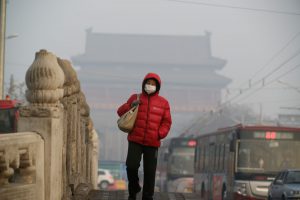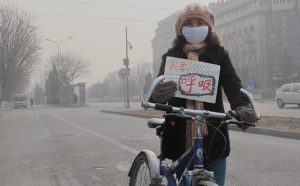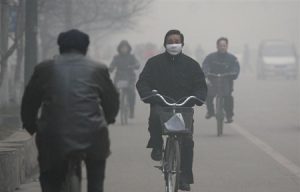Around 9,000 feet up, on a remote mountaintop in the state of Oregon, a group of researchers are on the lookout. It´s not planes or wildlife they are tracking but pollution clouds.
The monitoring site is run by Dan Jaffe, professor of atmospheric and environmental chemistry at the University of Washington-Bothell, who has spent the past 16 years trying to understand how pollution is carried around the world. Specifically, how a growing amount of pollution from China and the rest of Asia is being carried over the Pacific and dumped on the west coast of the US.
The impact is a fairly regular number of air pollution violations in US cities, directly attributed to pollution that originated in Asia.
With stricter controls in US cities on pollution, interest in Jaffe’s team’s work is growing, both from government officials and industry, which itself is under pressure to reduce the most harmful pollutants.
What’s more, major plans to scale-up the export of US coal to China are being questioned due to concerns it could contribute to worsening air pollution both at home and abroad.
Air pollution knows no boundaries
As Jaffe explains, the commonly heard phase “air pollution knows no boundaries” takes on a new meaning when we start to understand how pollution is travelling around the globe. The pollutants pumped out into the air never disappear into thin air, as we might like to believe.
Typical westerly wind flows across the mid-latitudes of the Northern Hemisphere mean air pollution from China is often carried over the Pacific Ocean. If the weather conditions are right, contaminants including mercury, ozone, sulphur and nitrogen oxides, black carbon and desert dust, can reach the west coast of the US within days.
The most visible recent examples were the giant dust storms originating from the Gobi desert in 1998 and 2001, which carried significant levels of pollutants across to the US. At the time, researchers feared this could be the start of an era of Chinese pollution dumping itself on the US. However, a similar large event has not occurred since, although smaller dust storms are still frequent.
Far more common, says Jaffe, have been the ozone events. These are not visible in the same way as giant dust storms, so haven´t garnered the same level of interest, but have proven to be damaging to public health and air quality standards. Levels of ozone detected at the mountaintop research centre have been "creeping up" over the past decade, according to data collected at the site, a result linked to, among factors, rapidly increasing vehicle emissions from Asia.
Whereas ozone high up in the atmosphere helps filter the sun’s ultra-violet rays, ozone closer to ground level causes lung damage and is a particular risk to young children and asthma sufferers.
"We can point to quite a number of days of high ozone reaching our research station and contributing to days that violate air standards across the US," says Jaffe. "They’re not as spectacular as dust storms and you don’t see them on satellite, but they are enough to break air quality standards two or three times a year."
Part of the problem is that standards in the US are getting higher, with the US Environmental Protection Agency (EPA) looking at tightening the emission rules because of the health implications of ozone. In a paper on the issue, International transport of air pollution, the EPA suggests that downwind air pollution from Asia would wipe out the improvements expected from recent national emission control programmes.
The realisation that air pollution can be transported thousands of miles from its source has led to a re-think among air-quality officials in US cities.
Legislation in the US designed to enforce air quality – principally the Clean Air Act – does have an exceptional events rule that grants cities exemptions if they can show the source of the bad air quality day was out of their control.
"In the past, when a city has a bad air day, they would normally assume the weather must have been too hot, the air stagnant, too many cars, factories. But there are days when they get bad air events and the air is not stagnant and they want to find out why," says Jaffe.
"It’s only really in the last few years that our research has got down to the city-level, where they are starting to look and understand global air pollution."
Mercury pollutants and fish
The other most significant pollutant is mercury. Asia burns a lot of coal, and Chinese coal in particular contains a high amount of mercury, making the country the largest source of chemical in the world. Although there are ongoing UN negotiations on reducing mercury emissions, expectations that China will be willing to invest in technology, or be given help in getting technology, to reduce atmospheric emissions of mercury are low.
"So when the global community says you need to spend millions cleaning up your mercury because high-end consumers in San Francisco can´t eat fish, China goes ‘give me a break that´s not our biggest problem’. Maybe in 10-20 years when it has dealt with its other issues it may be ready to tackle this,” says Jaffe, who adds that particulate matter (PM) air pollution in most Chinese cities, for example, is a much bigger problem.
Ironically, the US could also be contributing to its own mercury pollution too if it pushes through plans to scale up the export of coal to China.
US coal is already being exported to China through Canada. Just south of the west coast port city of Vancouver, the Westshore Coal Terminal ships 22 million tonnes of coal a year, of which 59% goes to China. There are now plans to build dozens of new terminals in the states of Washington and Oregon, on the west coast of the US, and export 150 million tonnes of coal a year to Asia.
"It’s a classic jobs versus environment," says Jaffe, who lives in Washington state, which is phasing out its only coal-burning power station. "It’s a dumb idea. We ship coal to China, they burn it and we get the pollution back."
A distant clean future
Jaffe believes both the US and China have different responsibilities when it comes to tackling air pollution. The US responsibility is maintaining high standards and not exporting coal to Asia, while for China it is continuing with what he says has been significant progress confronting its air quality problem.
"They´re putting huge amounts of money into science and technology and particularly environmental and air monitoring. You can now go online and get daily air-quality figures. I believe the data is fine. We´ve measured it ourselves. But if you convert it into western standards the levels are really high. The main difference is in the wording. They’re reporting the number correctly, but how they´re grading it is very different.
"In the long run, if they clean up their own environmental problems it will, by necessity, help their downstream neighbours. If they have such horrible air quality in their cities which they know is both a health and economic issue, are they’re going to spend 50 billion dollars on environmental progress to help their own citizens, or worry about people in Korea or the US?"



